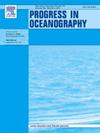Abyssal and hadal macroinbenthic assemblages in the eastern Aleutian Trench (NE Pacific)
IF 3.6
3区 地球科学
Q1 OCEANOGRAPHY
引用次数: 0
Abstract
The Aleutian Trench area is characterized by topographic and hydrographic discontinuities that may act as dispersal barriers, as well as strong environmental gradients that are likely to limit species distribution and promote diversification. The western part of the Aleutian Trench is comparably well studied, but there has been a paucity of benthic samples from its eastern part. This study aims to shed light on the benthic fauna of the eastern Aleutian Trench by analysing patterns in density and community structure of macrobenthic infauna, particularly isopod crustaceans and polychaetes, in relation to various environmental variables. The samples for this study were collected during the Aleutian Trench Biodiversity Studies (AleutBio) expedition (SO293) in 2022, which involved transects from north to south (abyssal North, hadal, abyssal South) along the Aleutian Trench and two sampling areas in the adjacent Bering Sea. In total, 14 stations at depths of 3,511–7,287 m were sampled using a box corer. Our findings indicated polychaetes to dominate macrofaunal communities followed by peracarids and molluscs. We observed a significant decrease in the densities of total macrofauna, polychaetes, and isopods with depth. There were no significant differences in macrofaunal composition at higher taxonomic levels, nor in the family-level composition of polychaetes and isopods between regions. Yet, at higher taxonomic resolution, i.e. genus and species level of Isopoda, the composition of isopods exhibited significant differences between the north and south abyssal as well as hadal region of the Aleutian Trench. Most isopod species identified (∼77%) were new to science and only a few were shared between regions or depth zonation. Additionally, the abyssal north Aleutian Trench showed a higher species diversity than the hadal and abyssal south. Overall, depth and sediment characteristics appeared to be the main drivers of differences in macrofaunal densities, community composition and isopod diversity. The study of deep-sea organisms, particularly isopods — one of the most abundant and diverse groups of macrofauna in the abyssal and hadal zones — is crucial for understanding, monitoring, and assessing the integrity of deep-sea benthic ecosystems. This includes assessing their biodiversity, distribution patterns, and the potential impacts of global change on species with limited dispersal capacity. However, more samples, higher taxonomic resolution and genetic analyses would help to elucidate ecological and environmental drivers of macrofaunal and especially isopod composition and connectivity across the trench.
东阿留申海沟(东北太平洋)深海和深海大型底栖生物群落
阿留申海沟地区的特点是地形和水文不连续,可能成为扩散障碍,以及可能限制物种分布和促进多样化的强烈环境梯度。阿留申海沟西部的研究相对较好,但其东部的底栖生物样本却很少。本研究旨在通过分析与各种环境变量相关的大型底栖动物,特别是等足类甲壳类动物和多毛类动物的密度和群落结构模式,揭示东阿留申海沟底栖动物。本研究的样本是在2022年阿留申海沟生物多样性研究(AleutBio)考察(SO293)期间收集的,该研究涉及沿阿留申海沟从北到南(深海北、深海、深海南)的样带和邻近白令海的两个采样区。总共有14个站在3,511-7,287米的深度使用箱盖取样。结果表明,大型动物群落以多毛类动物为主,其次是甲壳类动物和软体动物。我们观察到随着深度的增加,总大型动物、多毛类和等足类的密度显著下降。大动物组成在较高的分类水平上没有显著差异,多毛纲和等足纲的科级组成在不同地区之间也没有显著差异。然而,在较高的分类分辨率上,即属和种水平上,等足类的组成在南北深海以及阿留申海沟的hadal区表现出显著差异。大多数已确定的等足类物种(约77%)对科学来说是新的,只有少数物种在区域或深度带之间共享。此外,深海北部阿留申海沟的物种多样性高于深海和深海南部。总体而言,深度和沉积物特征似乎是大型动物密度、群落组成和等足类多样性差异的主要驱动因素。深海生物的研究,特别是等足类动物的研究,对于了解、监测和评估深海底栖生态系统的完整性至关重要。等足类动物是深海和浅滩区最丰富和最多样化的大型动物群之一。这包括评估它们的生物多样性、分布模式,以及全球变化对传播能力有限的物种的潜在影响。然而,更多的样本,更高的分类分辨率和遗传分析将有助于阐明大型动物,特别是等足类动物组成和连通性的生态和环境驱动因素。
本文章由计算机程序翻译,如有差异,请以英文原文为准。
求助全文
约1分钟内获得全文
求助全文
来源期刊

Progress in Oceanography
地学-海洋学
CiteScore
7.20
自引率
4.90%
发文量
138
审稿时长
3 months
期刊介绍:
Progress in Oceanography publishes the longer, more comprehensive papers that most oceanographers feel are necessary, on occasion, to do justice to their work. Contributions are generally either a review of an aspect of oceanography or a treatise on an expanding oceanographic subject. The articles cover the entire spectrum of disciplines within the science of oceanography. Occasionally volumes are devoted to collections of papers and conference proceedings of exceptional interest. Essential reading for all oceanographers.
 求助内容:
求助内容: 应助结果提醒方式:
应助结果提醒方式:


